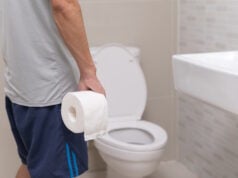
The average American suffers 96 bad hair days a year, according to new research.
A poll of 2,000 Americans discovered that the average respondent will have three months worth of bad hair days every single year.
That amounts to experiencing eight bad hair days a month, or slightly over a week trying to tame their locks.
From hair falling out when washing or brushing (46%) and general hair loss (35%) to frizzy (35%) and oily or greasy (33%) hair, Americans deal with a lot of unfortunate hair issues regularly.
The study, conducted by OnePoll in conjunction with Hairmax, found that four in five respondents have chosen to stay in rather than leave the house because they were having a bad hair day.
A third (33%) have even called in sick to work over a hair issue, with the average respondent saying they’ve called out sick five separate times because of a bad hair day.
But it’s not just the office that Americans avoid when they are dealing with a bad hair day. Half of those studied reveal they have bailed on a date due to an inability to get their hair to look good, while a further 38% have skipped a social function.
Another 43% have even bailed on a job interview due to a bad hair day.

On an especially good hair day, two in five of those surveyed report feeling more confident while a further 52% find themselves smiling more often.
Forty-six percent say that having thinning and lifeless looking hair is a tell-tale sign that it’ll be a bad hair day.
Another two in five say weird cowlicks are a definite sign of a bad hair day while 36% say sleeping on their hair funny can have them dealing with an unfortunate hair situation in the morning.
Unfortunately, 77% have felt less attractive because of their hair which is why 84% say their hair is a crucial component to their confidence overall.
“Great-looking hair is a major factor in people’s confidence,” said David Michaels, HairMax Founder. “In fact, experiencing thinning hair or hair loss may significantly lower one’s confidence overall. It’s better to deal with your hair imperfections at the first sign of trouble.
“Thinning hair can often be reversed, if you take charge by proactively using FDA-cleared, clinically-proven, science-backed solutions to re-grow your hair”
Americans have gotten savvy about covering up their bad hair days. Forty-four percent have worn a hat to cover-up their bad hair day while a further 43% have braided their hair in an attempt to corral their locks.
Some have gone to extremes to handle a bad hair day. Thirty-eight percent have used hair extensions or a hair piece to cover up a bad hair day while 29% simply avoided washing it.
“There are many factors that contribute to hair loss, mostly commonly menopause, aging, genetics and changes in hormones,” said Francesca Dubsky, Director of Marketing. “FDA accredited treatment options for people who want to help stop the progression of their hair thinning and regrow lost hair, include oral drugs and topical drugs – the only non-drug option is laser hair therapy, like HairMax”
TOP 5 SIGNS OF A BAD HAIR DAY
1. Hair looking thin and lifeless 46%
2. Weird cowlicks 40%
3. Sleeping on it funny 36%
4. Noticing hair loss 31%
5. Putting too much product on 27%
TOP 5 WAYS TO COVER-UP A BAD HAIR DAY
1. Wearing a hat 44%
2. Braiding it 43%
3. Using hair extensions or hair piece 38%
4. Using dry shampoo 30%
5. Avoiding washing it 29%












